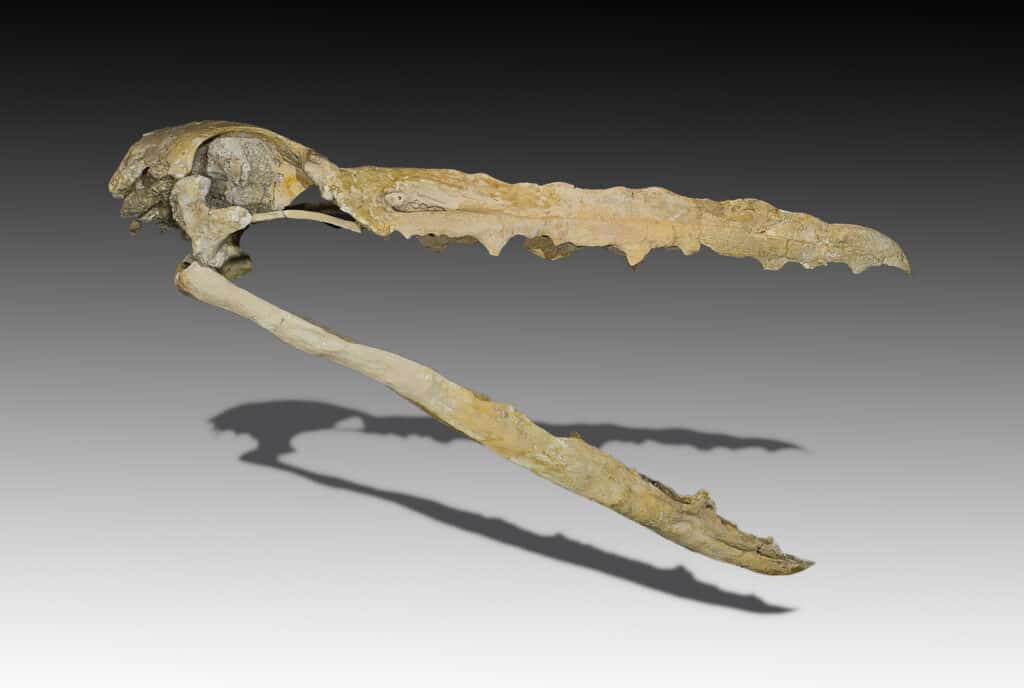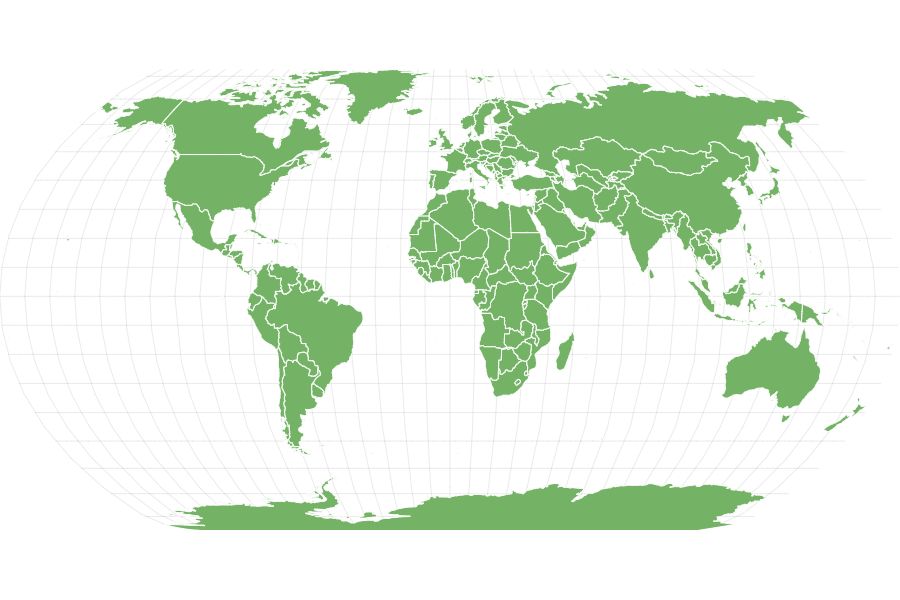The biggest members of the Pelagornithidae family were the largest flying birds known.
Advertisement
Pelagornithidae Scientific Classification
Read our Complete Guide to Classification of Animals.
Pelagornithidae Conservation Status
Pelagornithidae Facts
- Prey
- Cephalopods and fishes
- Main Prey
- Fishes
- Fun Fact
- The biggest members of the Pelagornithidae family were the largest flying birds known.
- Biggest Threat
- Sharks
- Most Distinctive Feature
- Tooth-like projections on the edge of their beaks.
- Distinctive Feature
- Massive wingspan 15–20 feet wide
- Other Name(s)
- Bony-toothed birds, pelagornithids, pseudodontorns, false-toothed birds
- Wingspan
- 15–20 feet
- Predators
- Sharks
- Diet
- Carnivore
- Favorite Food
- fishes and cephalopds
- Type
- Ancient bird
- Common Name
- Bony-toothed birds, false-toothed birds
- Special Features
- Tooth-like projections on the edge of their beaks.
Pelagornithidae Physical Characteristics
- Skin Type
- Feathers
- Weight
- 34–65 pounds
- Venomous
- No
- Aggression
- Low
View all of the Pelagornithidae images!
The biggest members of the Pelagornithidae family were the largest flying birds known.
The Pelagornithidae are a family of extinct seabirds that dominated the earth’s oceans during the Cenozoic. This bird had a long history beginning from the Late Paleocene to the Late Pliocene epoch. Although members of this family varied considerably in size, the biggest of them was the largest flying bird known to man.
Description and Size

The Pelagornithidae were large seabirds that dominated most oceans during the Cenozoic era.
©4,101 × 2,754 pixels, file size: 2.69 MB, MIME type: image/jpeg – License
The Pelagornithidae is a family of seabirds that dominated the planet’s oceans during the Cenozoic. Members of this family had widespread distribution of fossils on all continents of the world. Pelagornithidae lived for several million years until they disappeared roughly three million years ago.
The prehistoric family of large seabirds was also known by other common names such as bony-toothed birds, pelagornithids, pseudodontorns, false-toothed birds, or pseudo-toothed birds. All of these names refer to these birds’ most notable physical feature: the tooth-like projections on the edge of their beaks. Although they looked like teeth, the projections were simply an outgrowth of the birds’ premaxillary and mandibular bones.
Since the pelagornithid family was a large one, members of this family varied in size quite considerably. The small species of this family were about the same size as an albatross. The largest ones had a wingspan of about 15–20 feet (5–6 meters), making them one the largest flying birds to have ever lived.
Members of the pelagornithid family had thin-walled bones complete with air sacs. This made it easier for them to grow to such large sizes without losing their ability to fly. Unfortunately, it also means most of their limb bone fossils were not well-preserved in fossil records. This has made it difficult to estimate the exact weight of this bird. Rough mass estimates are quite low considering the massive size of this bird. However, experts think they were about 35–64 pounds or moderately above. The size is based on a well-preserved fossil from Miocene rocks in Chile.
They also had disproportionately short legs with webbed feet. Their feet had no toes, and their ankle bones looked like present-day albatrosses’.
Diet—What Did the Pelagornithidae Eat?
The pelagornithids were seabirds, meaning their diet consisted of aquatic animals. The exact diet composition of this carnivorous bird is unknown, but there are various speculations about what they might have fed on.
Scientists point to their false dentition and the presence of intraramal joints on their massive beaks as an indication that they preferred fish or squid. However, since the false teeth of the pelagornithids were not serrated and lacked any other specialized cutting edges (unlike those of prehistoric birds that predated them), experts think they were more useful for holding prey rather than tearing into flesh. This suggests that the giant bird most likely swallowed preys whole.
Their teeth were hollow or probably covered with cancellous bone, meaning they were not built to be resilient. Their prey probably consisted of soft-bodied animals such as cephalopods and soft-skinned fishes. However, given the large size of these birds, their prey was probably big as well.
There are controversies about how this bird might have hunted for prey. While some scientists think they might have dived into the ocean to fish for prey, the thin and delicate nature of their bones would have made this unlikely. Instead, they most likely picked up birds just below the ocean surface by submerging their beaks to pick them up.
Habitat—When and Where They Lived
The Pelagornithidae were large seabirds that dominated most oceans during the Cenozoic era. Fossils of this bird have been found on all continents, including Antarctica. Experts think they were migratory birds. They probably used the system of ocean currents and atmospheric circulation to migrate over the open oceans with specific breeding grounds, which they returned to for a few years.
Pelagornithids survived in a wide range of climates. There are speculations they might have shared the same habitats with the penguins and plotopterids. The pseudo-toothed birds also formed small flocks in upwelling regions which were presumably their breeding or feeding grounds.
Pelagornithidae—Threats and Predators
Pelagornithids were massive and capable of flight. This would have made it easy for them to escape predators. They probably didn’t face significant threats from the carnivorous land and sea animals that lived during the Cenozoic. Some scientists have pointed to the evolutionary radiation of the whales, seals, and other aquatic mammals as a possible threat—and likely reason for the extinction of the pelagornithids. However, this is very unlikely since the Pelagornithidae continued to thrive for several million years after whales evolved.
Few (if any) of the birds that coexisted with them would have been large enough to harm the largest pelagornithids. However, experts think early Eocene frigatebirds might have harassed the smaller species of this bird for food. There are also chances of them falling victim to sharks while feeding.
Discoveries and Fossils—Where the Pelagornithidae Were Found
Fossil remains of the Pelagornithidae have been found all over the world in rocks dating from the Early Paleocene to the late Pleistocene. Even though they survived until recently, the giant bird had extremely delicate bones. Thus, their remains were poorly preserved in the fossil records.
Parts of the skull and some beak pieces are the most commonly preserved. In February 2009, an almost complete skull of an Odontopteryx was discovered by scientists. The fossil was about nine million years old and was found in the Ocucaje District of Ica Province, Peru. This specimen is the best-preserved pelagornithid cranium ever found.
Extinction—When Did the Pelagornithidae Die Out?
Although competition with other seabirds and aquatic mammals for food and breeding grounds is commonly cited as a reason for the Pelagornithidae extinction, this is quite unlikely. While there are speculations about why they died out, there’s no single obvious explanation for their extinction.
A likely scenario points to the general ecological changes during the Late Pleistocene. This was probably worsened by the ice age and the change in ocean currents due to plate tectonics. Experts think the pseudo-toothed birds and many other Paleogene faunas could not adapt to these changes, eventually dying off.
Similar Animals to the Pelagornithidae
Similar animals to the Pelagornithidae include:
- Archaeopteryx: This is a genus of bird-like dinosaurs that lived during the Late Jurassic (about 150 million years ago). For several decades during the 19th century, scientists believed this bird to be the oldest bird species. This has since been disproved.
- Yanornis: This is an extinct genus of fish-eating birds that lived during the Early Cretaceous (about 120 million years ago)
- Pteranodon: This is a genus of pterosaur dinosaurs that lived during the Late Cretaceous. Members of this genus were the largest known flying reptiles.
Related Animal
View all 192 animals that start with PPelagornithidae FAQs (Frequently Asked Questions)
When was the Pelagornithidae alive?
The Pelagornithidae dominated earth’s ocean for up to 50 million years during the Cenozoic. They were alive until about 3 million years ago, going extinct towards the Pliocene-Pleistocene boundary.
How big were the Pelagornithidae?
Members of the Pelagornithidae family varied considerably in size. The smallest was about the same size as an albatross, while the largest ones had a wingspan of about 5–20 ft (5-6 meters), making them the largest flying birds to have ever lived.
Why did the pelagornithids go extinct?
Scientists don’t have a definite answer for why these giant birds went extinct. However, changes in the earth’s climate, ocean salinity, and an emerging ice age might have contributed to their eventual disappearance.
Thank you for reading! Have some feedback for us? Contact the AZ Animals editorial team.
Sources
- Wikipedia, Available here: https://en.wikipedia.org/wiki/Pelagornithidae
- Scientific Report / Peter A. Kloess, Ashley W. Poust & Thomas A. Stidham , Available here: https://www.nature.com/articles/s41598-020-75248-6

















